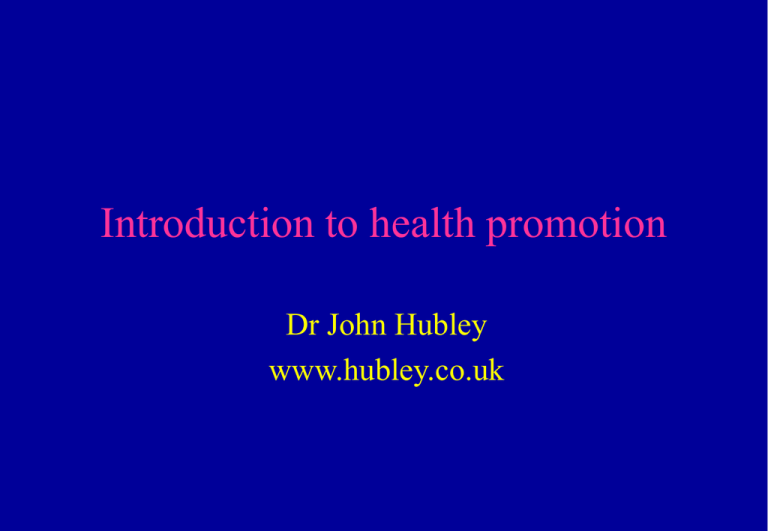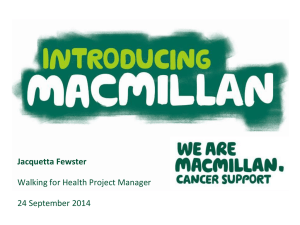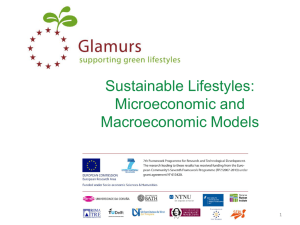
Introduction to health promotion
Dr John Hubley
www.hubley.co.uk
With acknowledgements to Dennis Burkitt
World Health Report 2002
• Simple, cost effective public health measures could
lengthen the average human life span by five to
10 years
• The top 10 risk factors accounting for about 40% of
the 56 million deaths in the world each year are
underweight in children and mothers; unsafe sex;
poor water, sanitation, and hygiene; indoor smoke
from solid fuels; iron deficiency; high blood pressure;
tobacco; alcohol; high cholesterol; and obesity. Two
other factors are important in the developing world:
zinc deficiency and vitamin A deficiency.
Health Field Model
Human Biology
(Genetics)
Life style
(Human
behaviour)
Health
Services
Environment
healthy
person
onset of
symptoms
(reversible)
Primary
prevention
advanced
symptoms
(not reversible )
Secondary
prevention
screening
case finding
early prevention
disabilty
death
Tertiary
prevention
rehabilitation
Primary
prevention
Actions carried
out with healthy
people to
maintain their
health and
prevent disease
Death rates from lung cancer (per 1000) by number of
cigarettes smoked, British doctors, 1951-61
Average number of cigarettes smoked per day
Secondary prevention
Actions to promote early interventions when
someone becomes ill to promote recovery and
prevent the condition from becoming worse
A calendar from
Cambodia promoting
the DOTS approach to
TB – essential to
ensure adherance to
prescribed doses
To ensure
effectiveness of
treatment and the
prevent the emergence
of antibiotic resistance
Types of behaviours
• Decision-based behaviours – where a person goes through a
conscious decision-making process before deciding to perform
(or not to perform the behaviour)
• One-time behaviour – a behaviour that a person is expected to
do only a few times in their life. (also usually a decision-based
behaviour).
• Routine behaviour – something people do regularly - usually
without a conscious decision (a behaviour might start as
decision-based and then become a routine as it is integrated into
their pattern of life)
• Addictive behaviour – when there is some physiological
reinforcement of the behaviour through a biological adaptation in
the person who becomes dependent on regular use of the
substance.
How realistic is this
message?
Do people living in
overcrowded housing have
any choice?
This is an example of
victim blaming health
education that puts all the
emphasis on individual
behaviour change and
ignores social and
economic influences on
the individual
This photograph of a
poster in a village in
Cambodia promoting
iodized salt for the
prevention of goitre.
One out every 4 –5
houses had stalls selling
cigarettes – but iodized
salt was not on sale.
It is not enough to do
health education – you
have to make the health
choice the easier one!
An effective response should
• Provide the information and power
for the community to make decisions
• Make the healthy choice the easiest
one
• Remove barriers to action
Ottawa Charter for Health Promotion
Health Promotion - the process of enabling people to increase control over, and to improve, their health.
Strengthen
Community
Action
Enable
Mediate
Advocate
Reorient
Health
Services
Develop
Personal
Skills
Create
Supportive
Environments
Source: Canadian Public Health Association - An International Conference on Health Promotion - November 17-21 1986
Promoting health
Health Education
Communication directed
at individuals, families
and communities to
influence:
awareness/knowledge
decision-making
beliefs/attitudes
empowerment
individual and community
action/behaviour change
community participation
Service
Improvement
Advocacy
improvements in
quality and quantity
of services:
agenda setting and
advocacy for healthy
public policy
accessibility
case management
counselling
patient education
outreach
social marketing
policies for health
income generation
removal of
obstacles
discrimination
inequalities
gender barriers
HESIAD Exercise
• Take a health topic
• In groups identify suitable actions that might be
taken for each component of HESIAD - health
education, service improvement and advocacy
Components of an
intervention
Health Education
directed at individuals,
families and communities
Service
improvement
improvements in
quality and quantity
of services:
Advocacy
agenda setting and
advocacy for healthy
public policy
Service Improvement
• Improvement in capacity of staff – training and
support
• Development of new activities
• Reorienting existing activities to make them
more effective/acceptable
• Strengthening communication/health
education within services
• Improved patient education
• Outreach to schools, community, workplace
• Involvement of personnel in supporting
community health promotion
Advocacy
• Influencing policy makers,
leaders and media to raise
profile of programmes
• Addressing legal, financial and
service obstacles to health
action
Equivalent terms
• Health education
• IEC (information, Education and
Communication)
• Behaviour Change Communication
• Social marketing
Why is health education essential
for promoting health?
• Community action to change surroundings - includes
community participation in health decision-making.
• Adoption of healthy life style – e.g. diet, life style, child care,
safety, stopping smoking, not taking drugs.
• Utilization of health services especially preventive services e.g.
ante-natal care, immunization, family planning, screening.
• Recognition and prompt self referral on early symptoms eg for
cancers, diabetes.
• Following (adhering to) prescribed medicines, completing
doses.
• Support for health promoting policies e.g. seat belt wearing,
traffic restrictions.
“any combination of learning opportunities
designed to facilitate voluntary adaptation of
behaviour which will improve or maintain
health”
Larry Green
"A process with intellectual, psychological and
social dimensions relating to activities that increase
the abilities of people to make informed decisions
affecting their personal family and community
well-being. This process, based on scientific
principles, facilitates learning and behavioural
change in both health personnel and consumers,
including children and youth
Helen Ross and Paul Mico
Levels for communication activities
Each level offers
opportunities for
different
communication
methods
individual
family
wider family
community
district
region
national
international
Each
level has
factors
which
influence
peoples’
actions
Critical decisions in Public
Health Education
•
•
•
•
•
Actions to be promoted
Target groups
Messages
Methods (settings, channels)
Delivery – timing
Some common settings for public education
school
Health facility
health facility
household
Schools
community
Programme planning for health promotion
Situation analysis
Plan health
promotion
Dialogue with stakeholders
literature reviews
Surveys to determine:
Baseline situation
Needs/Problems
Influences on problem at
different levels – community,
service and policy/society
level
Opportunities/resources
available to support
intervention
Strategy: mix of
advocacy, service
improvement and
health education
Implement health
promotion
Monitor progress
Evaluate impact
Activities
Targets/objectives
Management
Timing
Costs
Feedback from monitoring/evaluation







![Fundamental British Values-Policy Statem[...]](http://s3.studylib.net/store/data/006596948_1-c1ca6a86638c1896331809d11a593756-300x300.png)